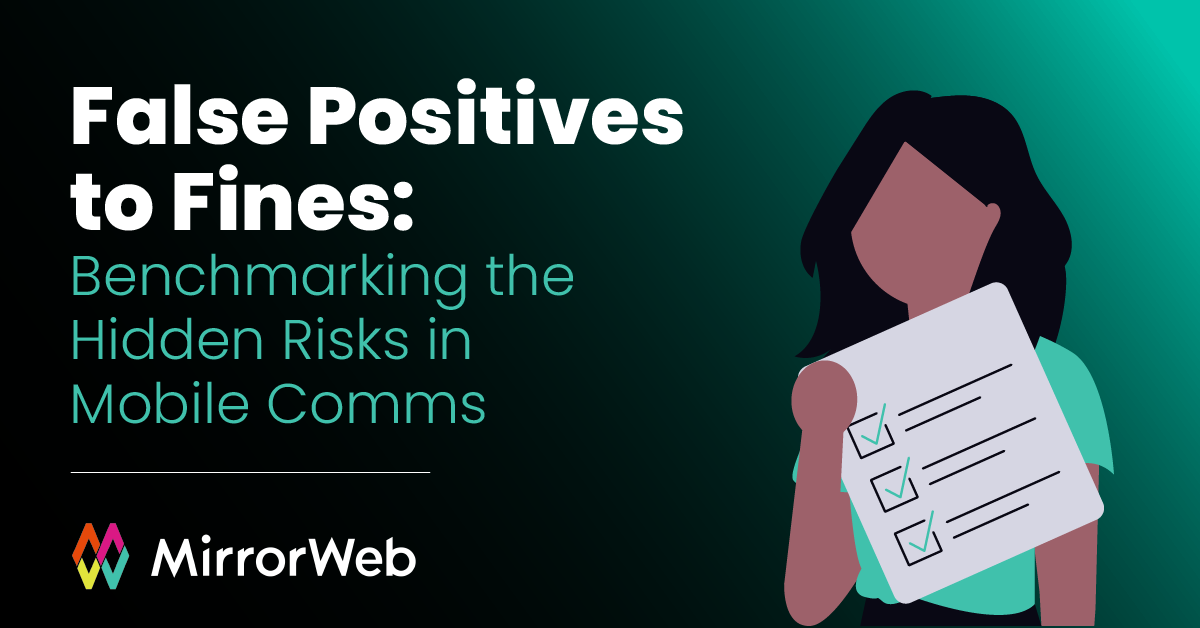Table of Contents
False positives are the hidden tax on mobile compliance that no one talks about - until now. While most firms accept $232,000 in annual waste as "the cost of doing business," our exclusive survey of 200 compliance leaders reveals an industry quietly divided between the efficient few and the struggling many.
That's the stark reality from MirrorWeb's new Benchmark Report, False Positives to Fines: Benchmarking the Hidden Risks in Mobile Comms - the first comprehensive study of mobile compliance costs and performance across U.S. financial services. The results expose an industry in crisis: only 25% of firms actually capture all mobile messages, while the majority rely on costly workarounds that are bleeding budget and missing risks.
The Foundation Problem: 75% of Firms Are Flying Blind
It starts with a shocking statistic that explains everything else in this report: only 25% of firms actually capture all mobile messages. The other 75% are making costly compromises that set them up for everything that follows.
Our benchmark data reveals the messy reality behind these gaps. 39% of organizations still insist on separate devices or apps for business communications which is the expensive, adoption-killing approach that creates more problems than it solves. Even worse, 12% of decision-makers believe compliance shouldn't monitor mobile communications at all, essentially gambling with nine-figure regulatory fines.
But here's where the real trouble begins. Even firms attempting mobile oversight are using tools that destroy the very context they need for accurate decisions. Most surveillance systems flatten WhatsApp threads into email blobs, strip away conversation timing, and eliminate the contextual clues that separate innocent banter from compliance violations.
When you can't see who replied to what, when reactions were added, or how conversations evolved, everything looks suspicious. This fundamental capture flaw creates the operational nightmare that's about to unfold.
The Operational Cascade: When Bad Capture Creates Compliance Theater
That capture gap doesn't just create blind spots - it triggers an avalanche of false positives that buries compliance teams in meaningless work. Our survey reveals the staggering scope of this operational drain:
78% of compliance teams face false positive alerts at least weekly. For 27%, it's every single day. Each misfire demands investigation time, pulling skilled analysts away from genuine risks to chase ghosts created by context-blind systems.
The human cost is brutal: compliance teams spend an average of 308 hours annually - around six hours every week - managing mobile communications surveillance. For 16% of firms, this commitment escalates beyond 500 hours annually, equating to more than one full working day per week of highly skilled resources dedicated to potentially meaningless alerts.
One private equity CCO in our study captured the frustration: "There's a lot of false positives. Someone has to read every message, understand the context, and verify whether there are any issues. If AI can take care of 80% of the work and just leave human validation on top, that's a huge time-saver."
But the operational problems don't stop with wasted analyst time. The noise is so overwhelming that it's creating a dangerous confidence gap in the technology meant to solve these problems. While 97% of firms are exploring AI-driven supervision, only 41% feel 'very confident' AI can accurately flag genuine violations.
Think about that disconnect, nearly every firm is investing in AI compliance tools, but less than half trust them to work correctly. When your primary detection system generates constant false alarms, even sophisticated AI becomes part of the problem rather than the solution.
This operational chaos sets the stage for an even more damaging consequence: the complete erosion of employee trust and participation.
The Human Rebellion: When Privacy Invasions Destroys Adoption
While compliance teams drown in false positives, the surveillance systems creating this mess are simultaneously alienating the very employees they're meant to monitor. Our research exposes a trust crisis that's sabotaging mobile compliance from within:
84% of compliance leaders report employee concerns about personal messages being swept into surveillance. This isn't theoretical worry, it's a rational response to systems that can't distinguish between your CEO's client text and their weekend family plans.
The employee pushback is destroying the adoption rates that compliance depends on. When staff know their private conversations might end up in compliance review, they find workarounds. They use unmonitored devices, switch to unauthorized apps, or simply avoid mobile communication for business entirely - creating the exact off-channel risks these systems were meant to prevent.
Adding to the human stress, our survey uncovered a compliance challenge that would be funny if it weren't so costly: 78% of compliance teams regularly encounter emojis in work communications that could create regulatory issues. What seems like innocent digital language becomes a compliance minefield when analysts must interpret whether that thumbs-up emoji indicates agreement to terms or that rocket ship suggests inappropriate risk-taking.
Meanwhile, the compliance teams tasked with managing this chaos are burning out under the operational load. The constant false positive investigations, the employee pushback, the pressure to catch genuine risks in an ocean of noise, it's creating a workforce management crisis alongside the compliance crisis.
But perhaps most dangerously, this combination of operational overload and employee resistance is blinding firms to a fundamental paradox in their effectiveness metrics.
The Dangerous Delusion: Why 59% Think They're Winning While Burning $232K
Here's where our benchmark research reveals the most troubling finding: 59% of senior leaders believe their mobile compliance approach improves productivity.
Let that sink in. While their teams spend 300+ hours annually chasing false positives, while employees rebel against privacy-invasive surveillance, while operational costs spiral toward a quarter-million annually, most leaders think their approach is working.
This mentality is expensive. Our analysis shows the average firm loses $232,457 annually to mobile compliance inefficiencies. For larger organizations, 13% of senior leaders estimate these costs exceed half a million dollars annually. Even smaller firms with fewer than 250 employees face substantial waste, with estimated annual expenses exceeding $68,000.
But the financial risk extends far beyond operational inefficiency. The capture gaps that started this cascade are exposing firms to the regulatory penalties they're spending fortunes trying to avoid. When only 25% of firms capture all messages and 12% don't monitor mobile communications at all, they're essentially inviting the kind of nine-figure texting fines the SEC has been issuing.
The regulatory scrutiny is intensifying, not retreating. 85% of senior compliance leaders report concern about potential fines or reputational damage due to non-compliance in mobile communications, with 51% describing avoiding mobile compliance fines as a "top priority."
Yet despite this acknowledged risk, the operational chaos created by inadequate systems is preventing firms from building the comprehensive oversight they know they need. They're trapped in a cycle: poor capture creates operational noise, operational overload prevents effective monitoring, ineffective monitoring increases regulatory risk, and regulatory pressure drives investment in more of the same inadequate approaches.
The Way Out: What the Efficient Few Do Differently
While 75% of firms struggle with this cascade of problems, our research identifies a small group that's broken free from the inefficiency trap. These leaders share three critical differentiators:
First, they capture communications in native format, preserving every thread, emoji, attachment, and edit exactly as it appeared. Instead of flattening conversations into context-free email blobs, they maintain the conversational flow that enables accurate, efficient review. The result: investigations close 2x faster and context-related compliance issues disappear.
Second, they use transparent AI that can explain every decision. Rather than black-box systems that generate unexplainable alerts, they deploy intelligence that shows exactly which rules triggered each flag. This builds internal confidence, enables regulatory discussions, and delivers up to 90% fewer false positives with 50% faster review times.
Third, they separate business and personal communications intelligently. Instead of invasive approaches that capture everything and sort later, they use smart contact identification that respects employee privacy while ensuring comprehensive business oversight. The result: higher adoption, fewer workarounds, and the trust needed for sustainable compliance.
The performance gap between these leaders and the industry majority continues widening. While average firms lose $232,000 annually to compliance theater, the efficient few have transformed those costs into competitive advantages - better risk detection, faster investigations, higher employee satisfaction, and audit-ready documentation that regulators trust.
The question isn't whether mobile compliance can be efficient and effective. Our benchmark proves it can. The question is whether your firm will join the 25% who've figured it out, or continue subsidizing the inefficiency tax that's bleeding talent, budget, and regulatory confidence.
Stop Paying the Inefficiency Tax - Get the Complete Roadmap
This cascade from capture gaps to financial waste is avoidable. Our benchmark study of 200 compliance leaders provides the complete roadmap for breaking free from the inefficiency trap.
Download the full report: False Positives to Fines: Benchmarking the Hidden Risks in Mobile Comms and discover:
- How firms are coping with the demands of mobile communications compliance
- The key challenges they're encountering — from false positives to privacy tensions
- Implementation strategies that reduce noise and build employee trust
- Regulatory readiness frameworks that turn compliance from cost center to competitive edge
- The role of AI in transforming manual oversight into intelligent, scalable control
See exactly where your firm stands in the efficiency spectrum and get the proven strategies top performers use to transform mobile compliance from operational drain to strategic asset.



